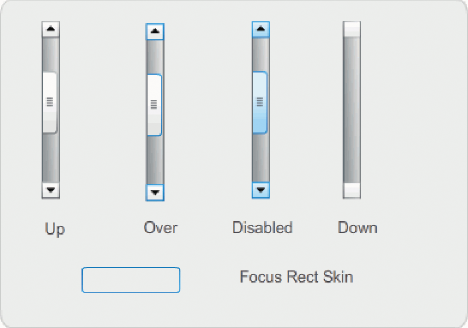|

You
can transform a UIScrollBar component horizontally and vertically
while authoring and at run time. However, a vertical UIScrollBar
does not allow you to modify the width, and a horizontal UIScrollBar
does not allow you to modify the height. While authoring, select
the component on the Stage and use the Free Transform tool or any
of the Modify > Transform commands. At run time, use
the
setSize()
method or any applicable properties
of the UIScrollBar class such as the
width
,
height
,
scaleX
,
and
scaleY
properties.
Note:
If you use the
setSize()
method,
you can change only the width of a horizontal scroll bar or the
height of a vertical scroll bar. At the time of authoring you can
set the height of a horizontal scroll bar or the width of a vertical
scroll bar, but the values will be reset when the movie is published.
Only the dimension of a scroll bar that corresponds to its length
can be changed.
Use styles with the UIScrollBar component
The UIScrollBar component’s
styles specify only the classes for its skins and a value for FocusRectPadding,
which specifies the number of pixels to use for padding between
the component’s bounding box and its outside boundary. For more
information about using skin styles, see
About Skins
.
Use skins with the UIScrollBar component
The UIScrollBar component uses the following skins.

UIScrollBar skins
Both horizontal and vertical
scroll bars use the same skins; when displaying a horizontal scroll
bar the UIScrollBar component rotates the skins as appropriate.
Note:
Changing the ScrollBar skin in one component
will change it in all other components that use the ScrollBar.
The following example demonstrates how to change the color of
the UIScrollBar's thumb and arrow buttons.
-
Create a new Flash document (ActionScript 3.0).
-
Drag the UIScrollBar component to the Stage and give it an
instance name of
mySb
. In the Parameters tab, set the direction
to horizontal.
-
Double-click the scroll bar to open its panel of skins.
-
Click the Up skin to select it.
-
Set the zoom control to 400% to enlarge the icon for editing.
-
Double-click the background of the right arrow (or up arrow
for a vertical scroll bar) until the background is selected and
its color appears in the Fill color picker in the Property inspector.
-
Select color #CC0033 to apply it to the button background.
-
Click the Back button at the left side of the edit bar above
the Stage until you return to document-editing mode.
-
Repeat steps 6, 7, and 8 for the thumb and the left-hand
arrow (or down arrow for a vertical scroll bar) elements.
-
Add the following code to the Actions panel on Frame 1 of
the Timeline to attach the scroll bar to a TextField.
var tf:TextField = new TextField();
addChild(tf);
tf.x = 150;
tf.y = 100;
mySb.width = tf.width = 200;
tf.height = 22;
tf.text = "All work and no play makes Jack a dull boy. All work and no play makes Jack a dull boy. All . . .";
mySb.y = tf.y + tf.height;
mySb.x = tf.x + tf.width;x
mySb.scrollTarget = tf;
-
Select Control > Test Movie.
The UIScrollBar
component should appear as it does in the following illustration.

Horizontal ScrollBar with thumb and left and right arrows
in red
|
|
|
